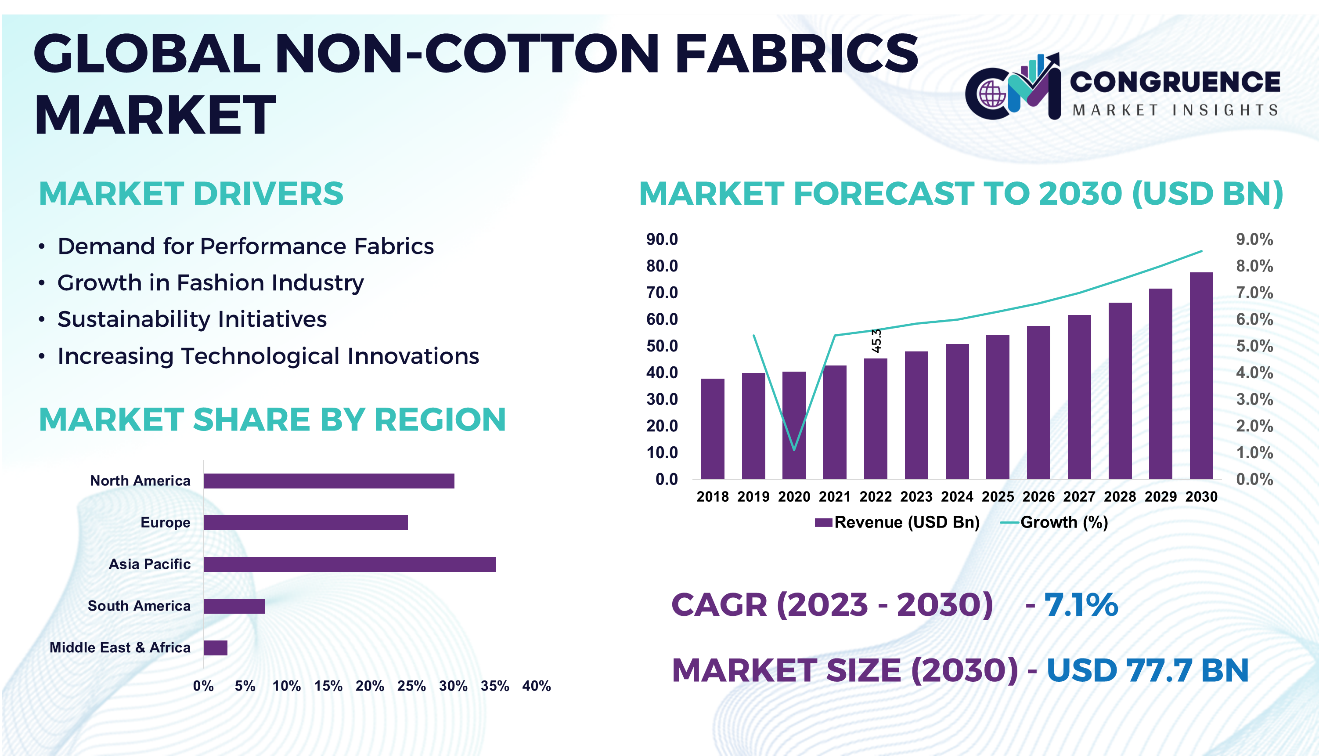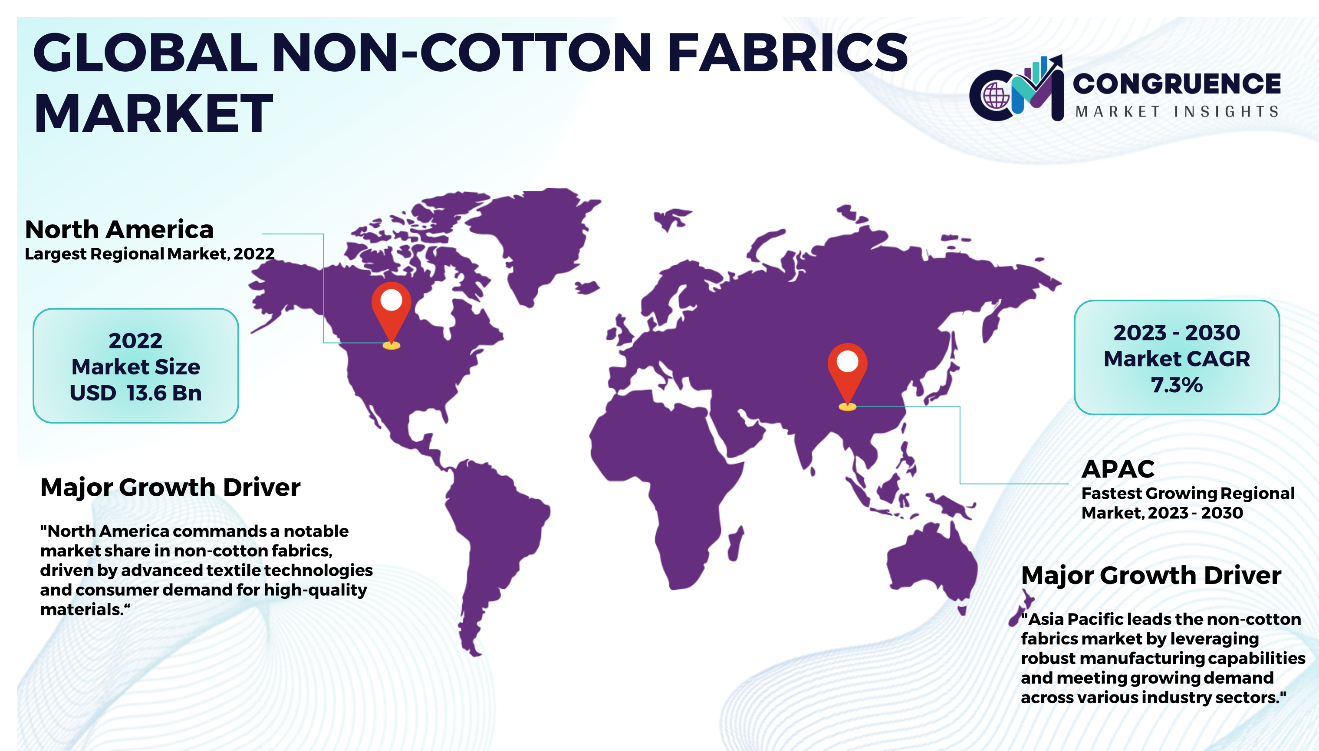Reports
The Global Non-Cotton Fabrics Market was valued at USD 45.3 Billion in 2022 and is anticipated to reach a value of USD 77.7 Billion by 2030 expanding at a CAGR of 7.1% between 2023 and 2030.
The textile business relies heavily on non-cotton textiles because they provide a variety of processing methods and advances in material science to satisfy changing customer demands. Differentiable materials with distinctive qualities and textures may be produced more easily thanks to techniques like knitting, weaving, and non-woven technologies. Developments in material science have made non-cotton textiles more adaptable to a wider range of uses by introducing sustainable fibers, performance-boosting additives, and specialty finishes. The need for these materials has been greatly increased by the growth of the fashion industry, especially with regard to its emphasis on performance and sustainability. Non-cotton textiles meet customer demands for fashionable and practical apparel by offering qualities like moisture-wicking, durability, and eco-friendliness. As a result, non-cotton textiles keep advancing innovation and reshaping the world of textiles.

To learn more about this report, request a free sample
copy
Non-Cotton Fabrics Market Major Driving Forces
Demand for Performance Fabrics: Demand for performance-enhancing textiles is growing as consumers lead busier and more health-conscious lives. Sportswear, athleisure, and outdoor clothes are three categories where fabrics with moisture-wicking capabilities, UV protection, and increased durability are highly sought for. The intrinsic performance support of synthetic fibers, such as nylon and polyester, makes them excellent choices for various applications.
Growth in Fashion Industry: The fashion business is always changing to reflect the shifting lifestyle and choice of its customers. The popularity of athleisure and casual clothing has raised the need for materials that are breathable, flexible, and comfortable. Non-cotton fibers are preferred because they may offer these useful qualities without sacrificing style, including spandex and mixes of polyester.
Sustainability Initiatives: The textile industry is investigating environmentally appropriate substitutes for traditional cotton due to sustainability initiatives and environmental concerns. Sustainable fabric solutions including bamboo-based textiles, lyocell, and recycled polyester are becoming more and more popular. These materials appeal to environmentally conscious consumers and lessen the negative effects of textile production on the environment.
Increasing Technological Innovations: Innovation in non-cotton textiles is fueled by developments in textile technology. Elaborate designs and patterns may be produced using digital printing processes, and smart fabrics are equipped with circuits for added functionality. Applications of nanotechnology improve fabric qualities including water resistance, stain resistance, and antimicrobial qualities, increasing the range of non-cotton materials in many sectors.
Non-Cotton Fabrics Market Key Opportunities
Advancements in Performance Textiles: As long as non-cotton materials are used in sportswear, activewear, and outdoor gear, there will be opportunities for non-cotton materials. To satisfy the needs of active lives, there are opportunities to produce materials with better moisture-wicking, UV protection, and antibacterial qualities.
Adoption of Digital Technologies: The textile industry can meet changing consumer demands for transparency and traceability while also optimizing production processes and improving supply chain efficiency by embracing digital technologies like blockchain, artificial intelligence, and machine learning.
Non-Cotton Fabrics Market Key Trends
· A rise in the market for environmentally friendly textiles made from plant-based fibers and recycled polyester.
· For activewear and outdoor wear, there is a growing emphasis on textiles with moisture-wicking, UV protection, and antibacterial qualities.
· The use of digital printing technology to create personalized designs, allowing textiles to have distinctive patterns and color variances.
· The incorporation of electronics into textiles for applications such as interactive apparel, health monitoring, and temperature control.
· Improvements made to the efficiency and quality of non-cotton textile production methods.
· Growing demand for distinctive and digitally printed textiles due to growing interest in personalized textiles and tailored clothing.
· An increasing number of medical textiles, such as surgical gowns, wound dressings, and protective clothing, are made of non-cotton materials.
Region-wise Market Insights
Asia Pacific accounted for the largest market share at 35.1% in 2022 and is expected to register the fastest growth, expanding at a CAGR of 7.3% between 2023 and 2030.

To learn more about this report, request a free sample
copy
With a strong emphasis on sustainability, sophisticated textile technology, and high consumer spending power, North America has a thriving non-cotton fabric sector. Diverse uses in the industrial, home textile, and clothing industries are driving demand in the area. The market for non-cotton materials is expanding rapidly in Europe, where innovation, quality, and sustainable practices are highly valued. Market growth is driven by the use of high-performance textiles and eco-friendly textiles. Asia Pacific is the market leader for non-cotton textiles because to its substantial textile industry infrastructure, low manufacturing costs, and growing demand in the home furnishings, clothing, and technical textile sectors. Non-cotton fabric production is steadily developing in South America due to the region's growing capacity for textile production, rising disposable income, and rising demand for stylish and high-quality textiles. Middle East & Africa shows promising growth potential in the non-cotton fabrics market, supported by improving industrial infrastructure, rising consumer awareness, and investments in textile manufacturing technologies.
Market Competition Landscape
The market for non-cotton textiles is defined by fierce rivalry as top suppliers and manufacturers compete to gain market share. Advanced production processes, customisation capabilities, and sustainable material advances are critical competitive dynamics. Businesses set themselves apart from the competition with their performance characteristics, product quality, and ability to adapt to changing customer needs. To obtain a competitive edge, top businesses also place a high priority on distribution networks, branding, and strategic alliances. Market positioning heavily depends on adherence to regulatory norms, especially those pertaining to environmental sustainability. Generally, ongoing attempts to improve product offers, increase market presence, and conform to new trends in non-cotton materials are what propel this competitive environment.
Key players in the global non-cotton fabrics market implement various organic and inorganic strategies to strengthen and improve their market positioning. Prominent players in the market include:
· DuPont
· Toray Industries, Inc.
· Indorama Ventures Public Company Limited
· Hyosung Corporation
· Lenzing AG
· Teijin Limited
· Far Eastern New Century Corporation
· SRF Limited
· Huntsman Corporation
· Formosa Plastics Corporation
· Asahi Kasei Corporation
· Reliance Industries Limited
· Mitsui Chemicals, Inc.
· Asahi Industries Co., Ltd.
|
Report Attribute/Metric |
Details |
|
Market Revenue in 2022 |
USD 45.3 Billion |
|
Market Revenue in 2030 |
USD 77.7 Billion |
|
CAGR (2023 – 2030) |
7.1% |
|
Base Year |
2022 |
|
Forecast Period |
2023 – 2030 |
|
Historical Data |
2018 to 2022 |
|
Forecast Unit |
Value (US$ Bn) |
|
Key Report Deliverable |
Revenue Forecast, Growth Trends, Market Dynamics, Segmental Overview, Regional and Country-wise Analysis, Competition Landscape |
|
Segments Covered |
· By Fabric Type (Synthetic, Natural, and Blended) · By Processing Technique (Woven, Knitted, and Non-Woven) · By End-Use (Fashion and Apparel, Furniture Textile and Home Textile, and Industrial Textile) |
|
Geographies Covered |
North America: U.S., Canada and Mexico Europe: Germany, France, U.K., Italy, Spain, and Rest of Europe Asia Pacific: China, India, Japan, South Korea, Southeast Asia, and Rest of Asia Pacific South America: Brazil, Argentina, and Rest of Latin America Middle East & Africa: GCC Countries, South Africa, and Rest of Middle East & Africa |
|
Key Players Analyzed |
DuPont, Toray Industries, Inc., Indorama Ventures Public Company Limited, Hyosung Corporation, Lenzing AG, Teijin Limited, Far Eastern New Century Corporation, SRF Limited, Huntsman Corporation, Formosa Plastics Corporation, Asahi Kasei Corporation, Reliance Industries Limited, Mitsui Chemicals, Inc., Asahi Industries Co., Ltd. |
|
Customization & Pricing |
Available on Request (10% Customization is Free) |
